Kunming – The Spring City Posted by sasha on Jun 23, 2015 in Culture
Recently, I wrote a short post about Kunming in Chinese. Due to my low-level of Chinese writing abilities, I wasn’t able to say a whole lot about my new home in that post. Plus, I realize that for a lot of our readers, a post like that is quite hard to follow. Never fear, because today I’m bringing you a post in English about Kunming, with some useful Chinese vocabulary thrown in for good measure.
A Brief Introduction
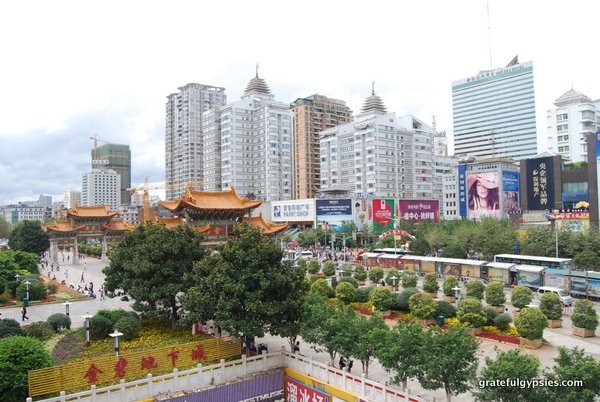
Downtown Kunming
Kunming is the provincial capital of Yunnan and is also the largest city. It serves as the political, educational, cultural, and economic center of the province, and it’s a major transportation hub linking China to SE Asia. With a population of just under 6.5 million, it’s the 16th-largest city in China. Like much of China, the city has been growing at breakneck speed, with old buildings meeting the wrecking ball and high-rises going up in their places. Despite its rapid development, Kunming still feels worlds apart from the mega-cities such as Beijing, Guangzhou, and Shanghai.
Weather

Another beautiful Kunming day.
Although it’s located pretty far south, Kunming’s elevation helps keep the weather nice and mild. Denver might be the Mile High City, but Kunming is actually higher than the Colorado capital (ok, maybe not in some ways – there’s no legal weed here). It’s known as the Spring City in Chinese thanks to its pleasant weather. It never really gets that hot during the summer, and snowfall is almost unheard of in winter. As a result, homes and offices here do not have either central heat or air conditioning. Unlike other big cities in China, the air in Kunming is actually quite clean – no need for apocalyptic face masks here!
Sightseeing

Yuantong Temple
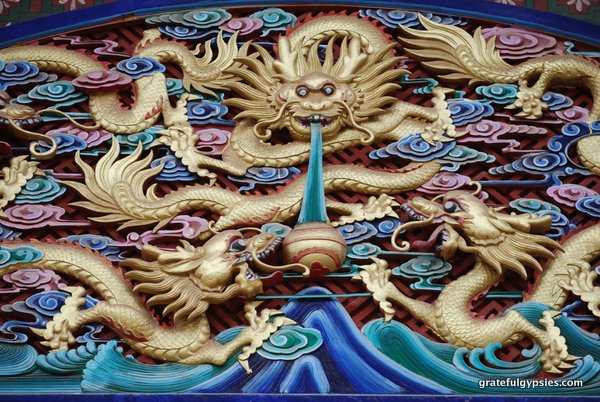
Dragon carving in a Kunming temple.
There’s not nearly as much to see here as in cities like Beijing, nor is there one major tourist attraction that brings people in such as the Terracotta Warriors of Xi’an. There are, however, quite a few interesting places to visit in and around the city. Perhaps the most famous tourist attraction is the Stone Forest, which is actually quite far (60 miles) from the city center. Inside of the city, it’s all about parks, temples, and museums. A stroll around Green Lake Park is one of the best things you can do in Kunming, which along with a stop at Yuantong Temple makes for a great and cheap day of sightseeing – the park is free and entrance to the temple is just 6 RMB ($1).
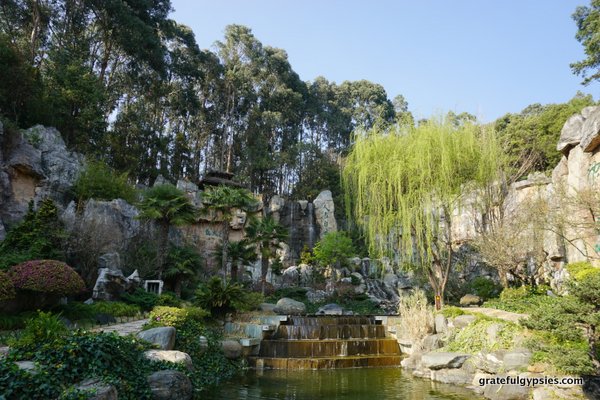
Kunming World Expo Garden
A bus ride can take you to lots of scenic areas on the outskirts of the city, such as the World Expo Gardens, Grand View Park, or the Western Hills. With mountains and lakes so close by, it’s easy to escape the concrete jungle and get out in nature, even if only for a couple of hours. There are lots of great options for day trips as well, such as Fuxian Lake or the hot springs of Yuxi.
Culture

Sleeping on a park bench – what an old watch.
When you talk about the local culture in the Spring City, you’d better do it in Kunming hua (the local dialect). The pronunciation is quite different from standard Mandarin, so don’t be surprised if you can’t understand local people chatting with each other here. Explaining Kunming hua is a bit tricky, but thankfully some readers of GoKunming have put together a useful guide. My personal favorite word in Kunming hua is “old watch” (老表 – lǎo biǎo), which basically means “redneck,” or “wanker” for our British friends out there.
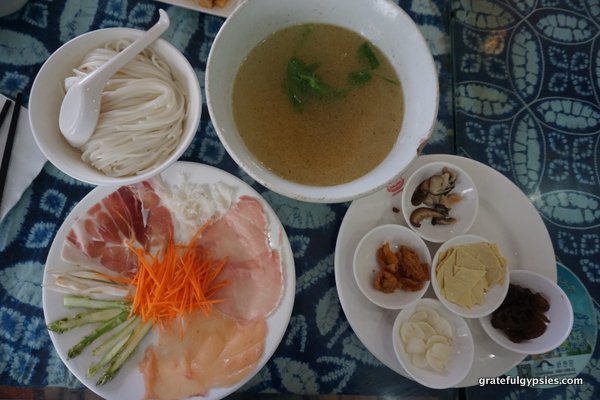
Over the bridge rice noodles.
As is the case with just about every city in China, the cuisine is a big part of the culture here. By far the most famous dish is “Over the Bridge Rice Noodles” – a stone pot of rice noodles accompanied by a variety of things that are added to the bowl, such as ham, mushrooms, and quail eggs. These famous noodles can be found just about anywhere in China, and on nearly ever street corner in Kunming.

Colorful ethnic minorities of Yunnan.
Many of China’s ethnic minority groups call Yunnan province home, making for an interesting cultural mix in Kunming. The largest group in the city are the Yi (彝族), at around 400,000. Walk around Green Lake over the weekend, and you’ll see lots of ethnic minority people dressed in their extremely colorful garb, dancing, singing, and playing traditional instruments.
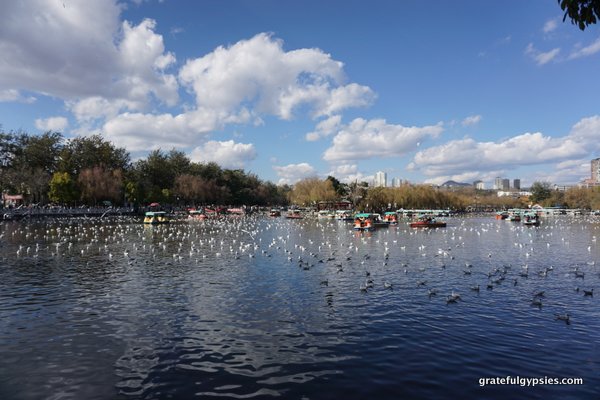
Kunming’s famous seagulls.
Another interesting aspect of Kunming culture is the city’s obsession with seagulls. Every winter, thousands of gulls flock here from Siberia and gather around the Green Lake. Locals and tourists adore the birds, as they happily fork over their RMB for bags of breadcrumbs to feed them. Some even pay to have their photo taken with one. This is a stark contrast to my hometown, where we absolutely loathe these annoying flying rats who swarm our picnics and crap on boats.
Nightlife
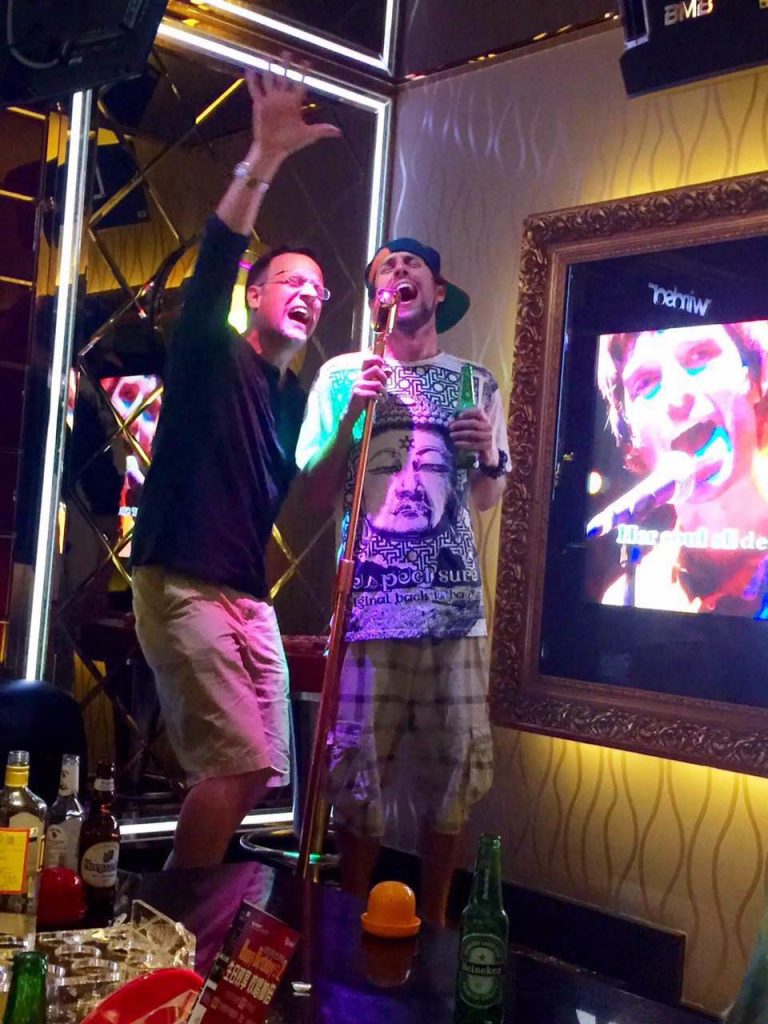
Singing my heart out at KTV.
For all the night owls, there’s plenty to do in Kunming. Of course, the local favorite is a night of drunken singing at one of the city’s countless KTV joints. On Wenlin Street, there are quite a few bars that are primarily frequented by locals looking to show off. As for the city’s expat population, they can usually be found drinking on the porch at Salvador’s, doing pub quiz at O’Reilly’s, or engaging in a heated game of foosball at the legendary Moondog. The city’s nightlife is centered around one square, called Kundu. Here, you’ll find quite a few pretentious night clubs and one cool bar – the Mask. They host a weekly open mic night, and always have live music going til the wee hours of the morning on weekends.
Vocabulary
-
Kunming (昆明 – kūn míng)
-
Yunnan province (云南省 – yún nán shěng)
-
provincial capital (省会 – shěng huì)
-
Spring City (春城 – chūn chéng)
-
Green Lake park (翠湖公园 – cuì hú gōng yuán)
-
Yuantong temple (圆通寺 – yuán tōng sì)
-
Western Hills (西山 – xī shān)
-
Grand View Park (大观楼 – dà guān lóu)
-
Expo Garden (世博园 – shì bó yuán)
-
Kunming dialect (昆明话 – kūn míng huà)
-
“old watch” (老表 – lǎo biǎo)
-
over the bridge rice noodles (过桥米线 – guò qiáo mǐ xiàn)
-
ethnic minority (少数民族 – shǎo shù mín zú)
-
Yi people (彝族 – yí zú)
-
seagull (海鸥 – hǎi ōu)
-
The Mask bar (脸谱酒吧 – liǎn pǔ jiǔ bā)

Build vocabulary, practice pronunciation, and more with Transparent Language Online. Available anytime, anywhere, on any device.
About the Author: sasha
Sasha is an English teacher, writer, photographer, and videographer from the great state of Michigan. Upon graduating from Michigan State University, he moved to China and spent 5+ years living, working, studying, and traveling there. He also studied Indonesian Language & Culture in Bali for a year. He and his wife run the travel blog Grateful Gypsies, and they're currently trying the digital nomad lifestyle across Latin America.




Comments:
Philippe:
actually the Mask in Kundu is 脸谱酒吧
Peter Simon:
Dear Sasha,
Thank you again for the great post. I have a few questions though.
I’m aware of problems with population statistics and you’re saying that at 6.5 mill, “Kunming still feels worlds apart from the mega-cities such as Beijing, Guangzhou, and Shanghai.” In what ways?
I’m asking this because I know Beijing, Shanghai, Hangzhou and Xi’An quite well, but the city where I used to live, Shaoxing, at 3 mill in the book, but actually a half-million, but very dynamic rural city, didn’t feel much different from them at the time – it depends where you’re standing in, say, Beijing.
Another Q is the meaning of 6.5 mill. Does that mean the city-proper, or with the loosely-defined area? At 6.5 within the city limits, it would come in second in the US, well ahead of Los Angeles, and fourth in the whole of Europe ahead of Saint Petersburg. The real problem for me is, to what extent does size define your feelings.
One more. You’ve mentioned that seagulls from Siberia fly into the city every winter. Well, seagulls are called seagulls because they don’t fly inland. You wouldn’t see many of them in Derby, Birmingham or Sheffield, a wee 60 miles from the British coast at the most. They don’t like flying non-stop over areas without fish. Kunming seems to be closest to the Vietnam shore at a distance of at least 500 miles and even the southern border of Russia/Siberia is about 3000 (over arid Mongolia) with another 4000 to the nearest sea in any direction from there (with nothing but the taiga and then the tundra below). So, my Q is, aren’t they localised birds by any chance (like those having settled down on the lakes in Arnhem, East-Netherlands, about a 100 km from the North See)? Or not seagulls at all? They could perhaps be a sort of gulls that have nothing to do with their cousins elsewhere.
Just interested in the strange. You may have very simple answers, please let me know. Greetings, Peter
sunshine:
i am sooooooo ready to trek over there. Peace out from Chicago. Zai jian! keep up the amazing blogging !
sunshine:
your blog on your new home in 3 different text was amazing! xiexie
sasha:
Thanks for the comments, everyone! Glad to see so much interest in Kunming!
Peter – The 6.5 million figure is the entire prefecture area of Kunming. In the city it’s just under 4 million. The reason I say it feels world’s apart from BJ or Shanghai is because despite the high number, it just never feels that crowded there. The traffic gets a little bad but not even close to those other cities. There’s barely any pollution and the sky is blue every day unless it’s actually cloudy. Also, people are just much more relaxed – not in a huge hurry, not pushing everyone out of the way, not cursing at each other on the road. As far as the seagulls go, they’re famous in KM because they’ve been flying there every winter since 1985. I don’t see them there at other times in the year, so I definitely believe the story that they fly in for the winter every year. They must find some fish somewhere… or they just know all the locals and tourists in KM will be ready to take them in with plenty of bread crumbs!
Peter Simon:
Sasha,
Thanks for the data on Kunming. Sounds perfectly suitable for me 🙂 without the pollution and hurry elsewhere. Hope you’ll also come to appreciate it in a more positive way (like, instead of ‘it doesn’t feel like elsewhere’, you can feel ‘wow, this is also possible in China’ :)).
As to the seagulls, I’m not convinced. They just don’t migrate. Like the black crows in Hungary, or here in the Netherlands: you won’t see them in good weather, but they flock cities’ large trees in winter. There must be some good lakes around Kunming where those gulls can enjoy summers.
Best,
P